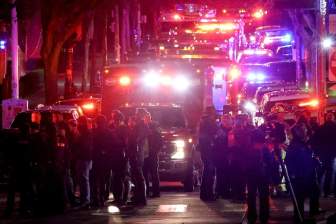It started early on Sunday, on a stretch of the Coquihalla Highway about 10 minutes south of Merritt, B.C.

A small Mustang II plane dipped low in the skies above and then, to the shock of passing motorists, landed on the grassy median between the highway lanes.
The pilot was unhurt, and the incident was chalked up to a mechanical failure. There was no rain, no heavy cloud cover. Police attended the scene, the Transportation Safety Board was made aware of the unorthodox landing, and everyone moved on.
WATCH: Pilots put in a lot of training time, both in the classroom and in the air, before getting their license. Bindu Suri explains how much of a pilot’s training focuses on emergency landing practices.

Then, a few hours later, it happened again.
This time, it was on a highway near Chelsea, Que. Another clear afternoon, another small aircraft with reported mechanical trouble landing with no injuries reported. More baffled motorists, more police, and another call to the TSB.
READ MORE: Passenger killed after engine fails, window shatters on Southwest Airlines flight

That, in itself, was coincidence enough. But on Wednesday morning, a twin-engine six-seater touched down on a (thankfully empty) stretch of road near the Trans Canada Highway in Calgary, and made it a hat trick.

Get breaking National news
Federal officials have been left scratching their heads.
“You could consider this a coincidence,” said Alexandre Fournier, a TSB spokesperson based in Quebec.
“In the case of the one here in Chelsea and the one in B.C., … weather could be a factor. Spring is coming back so people are going out, including pilots.”
The truth is, nobody is quite sure what’s going on yet. Fournier said the TSB is currently looking into all three incidents. He confirmed that this type of landing on a roadway is very rare. Three in quick succession is unheard of.
“They all have their own characteristics. When we do these examinations, (if) we note a trend, we will definitely do a further analysis to see if there is anything behind such a trend.”
WATCH: TSB begins investigation into plane landing on Calgary road

Greg McConnell, national chair of the Canadian Federal Pilots Association (CFPA), isn’t quite sure about the TSB’s assessment so far.
“Coincidence might be an easy way out,” he said.
McConnell’s organization has long been concerned about a general decrease in Transport Canada’s regulatory oversight in the skies.
The small planes that landed in Quebec and B.C. appeared to have been controlled by private pilots who were likely aviation enthusiasts, which would mean they fall under Canada’s general aviation sector (in Calgary, the small plane was owned and operated by a company, Super T Aviation).
“Some of the (private pilots) buy their own airplanes, and some go to local flying clubs and rent the airplanes, and then they just fly them at leisure,” McConnell explained.
These pilots are still subject to training, regulatory requirements and other rules, he noted, but they also used to have regular access to updates and briefings through Transport Canada’s now-disbanded regional system safety offices.
“If Transport Canada isn’t around saying hello to them, are you going to start letting things slip?”
Transport Canada did recently announce a series of safety seminars would be held this year across Canada for the general aviation community, but no dates have been set.
A ‘suitable’ landing spot
McConnell said pilots of all backgrounds are generally taught that, if something goes wrong and they can’t land at an airport, they should find a “suitable” place to set down.
There’s no ideal location that works in every emergency, but in all three cases this week, the best option seems to have been a paved roadway.
A highway is basically no different than a runway in many respects, McConnell acknowledged. But there is still the potential for encountering not only moving vehicles, but also road signs, power lines and other obstructions.
“I would suggest that a farmer’s field, that freshly has the hay or the wheat off of it, might also be a suitable place depending on the length of the field and the obstructions in and around the field.”
READ MORE: Airlines in Canada ‘on the precipice of something bad,’ say critics
Praveen Premchandran, an assistant chief flight instructor at Mount Royal University in Calgary, told Global News on Wednesday that making a safe emergency landing usually depends on how high you are, and pilots have only a matter of minutes to decide where to land.
Premchandran’s students are trained for every possible emergency, including extreme turbulence and engine failure, he added.
WATCH: Lack of safety knowledge puts airline passengers at risk

This week certainly doesn’t mark the first time a small plane has made an emergency landing away from an airport in Canada. One crashed in a farmer’s field southeast of Calgary in November of 2012, for instance, landing upside down. Amazingly, nobody was hurt.
In August 2013, a Cessna-182 Skylane came to rest in a ditch off highway 40 near Kananaskis Country, Alta., after the engine failed. The pilot and his passenger also walked away uninjured.
—With files from Bindu Suri
- Winter storms, rain and snow wallopping Canada. Here’s where you’ll see it
- ‘We do not give in to terror’: Canadians voice support for Sydney Hanukkah shooting victims
- ‘Really challenging issue’: Many B.C. communities still at high risk for flooding
- Cold warnings across the Prairies forecast wind-chill temperatures near -45 C








Comments